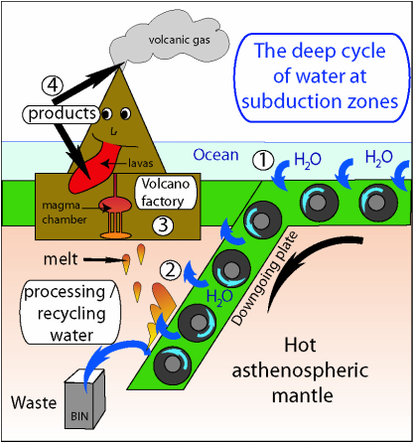The fate of water
What happens to the water during its cycle into the deep Earth? Is it all fluxed back to the surface or is it lost into the deep Earth?
Water is the one of most important elements of our planet. It covers 71% of the Earth's surface and it forms the oceans, the rivers, the rain and the lake (also called the hydrosphere). Water is also the major constituant of most of the living forms (such as plants, animals, human beings). Hence, water is essential to the life on Earth and it makes our planet habitable. The Earth is also called the "blue planet" because most of its surface is covered by oceans. In simple words, without water our planet would look different and life as we know it would not exist. Because water is so essential to every living forms on Earth, we need to understand what happens to the water during its cycle into the deep Earth.

Sketch showing the deep water cycle at subduction zones, inspired from the Subduction Factory. (1) Water is trapped in minerals because of seafloor alteration during plate formation. (2) As pressure and temperature increase during subduction, some of the water is released to trigger melting of the hot mantle. (3) Water is processed as a melt that erupts as lavas or form gas (4) in the volcano factory.
|
Water is recycled into the deep Earth and returned back to the surface via subduction zones. Subduction zones are places where one plate goes underneath another plate. Because plates are hydrated (enriched in seawater) during their formation on the seafloor (1), they can release their bounded water as the plate goes down (2), as pressure and temperature increase.
Just think of it as cooking rice. When you cook rice, you need to add water to it. As your rice cooks, it trapps water (the water is not free anymore but is bounded to rice). If you put your cooked rice into the oven, and you increase the temperature, it will lose its water and dry out ! This is exactly what happens to the oceanic plate during its formation on the seafloor (it is enriched in water) and dehydrates (it loses water) during subduction. |
As the sinking plate dehydrates, it releases its water into the hot mantle to trigger magmastism. Melts thus (3) erupt to the surface as water-rich lavas. Water can also be recycled back to the atmosphere as volcanic gas (4). Some of this water is not recycled to the surface, but lost ("wasted") into the deep Earth.
One questions that I seek to address is how much water is recycled to the surface via magmatism and degassing or lost during subduction?
One questions that I seek to address is how much water is recycled to the surface via magmatism and degassing or lost during subduction?
